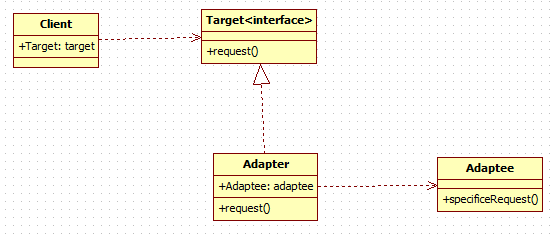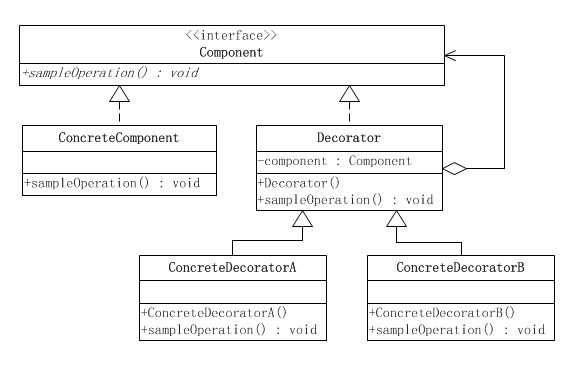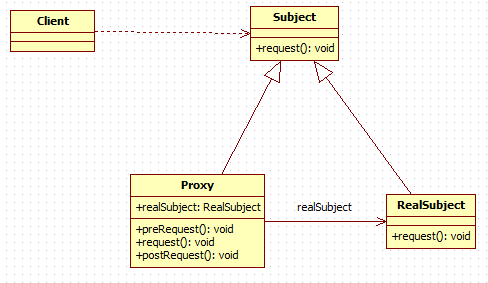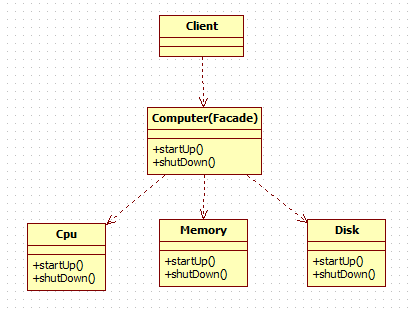适配器模式:将一个接口转换成客户端希望的另一个接口,实现不同接口的兼容。有对象适配和类适配两种,用得较多的是对象适配。对象适配其类图如下:
示例代码如下:
package com.peacentury.adapter;
public interface Target {
public void request();
}
package com.peacentury.adapter;
public class Adapter implements Target{
Adaptee adaptee;
public Adapter(Adaptee adaptee){
this.adaptee = adaptee;
}
@Override
public void request() {
adaptee.specificRequest();
}
}
package com.peacentury.adapter;
public class Adaptee {
public void specificRequest(){
System.out.println("adaptee mothod");
}
}
package com.peacentury.adapter;
public class Client {
public static void main(String[] args) {
Adaptee adaptee = new Adaptee();
Target target = new Adapter(adaptee);
target.request();
}
}
类适配中,需要适配器继承被适配的类,则此时Target只能是接口(Interface),否则会违背Java中当继承的原则。其类图如下:
装饰模式,总是觉得装饰模式好像挺熟悉的,因为IO中的读写流都用到了装饰,正真理解起来还是花了点时间。装饰模式多数用于动态的添加相关类的功能,比生成子类更灵活,同时实现代码的复用。装饰模式中的角色有1、抽象构件(Component)2、具体构件(Concrete Component)3、装饰器(Decorator)4、具体装饰器(Concrete Decorator)。其类图如下:
具体例子的类图如下:
示例代码如下:
package com.peacentury.decorator;
public interface TransportationTool {
public void move();
}
package com.peacentury.decorator;
public class Car implements TransportationTool {
@Override
public void move() {
System.out.println("the car can move.");
}
}
package com.peacentury.decorator;
public class Bus implements TransportationTool {
@Override
public void move() {
System.out.println("the bus can move.");
}
}
package com.peacentury.decorator;
public class Decorator implements TransportationTool {
private TransportationTool tool;
public Decorator(TransportationTool tool) {
this.tool = tool;
}
@Override
public void move() {
tool.move();
}
}
package com.peacentury.decorator;
public class RunDecorator extends Decorator {
public RunDecorator(TransportationTool tool) {
super(tool);
}
@Override
public void move() {
super.move();
this.run();
}
public void run(){
System.out.println("it can run.");
}
}
package com.peacentury.decorator;
public class SwimDecorator extends Decorator {
public SwimDecorator(TransportationTool tool) {
super(tool);
}
@Override
public void move() {
super.move();
this.swim();
}
public void swim(){
System.out.println("it can swim.");
}
}
package com.peacentury.decorator;
public class FlyDecorator extends Decorator {
public FlyDecorator(TransportationTool tool) {
super(tool);
}
@Override
public void move() {
super.move();
this.fly();
}
public void fly(){
System.out.println("it can fly.");
}
}
package com.peacentury.decorator;
public class Client {
public static void main(String[] args) {
TransportationTool car = new Car();
new FlyDecorator(new SwimDecorator(new RunDecorator(car))).move();
System.out.println("------- a bus in Wuhan--------");
TransportationTool wuhanBus = new Bus();
new SwimDecorator(new RunDecorator(wuhanBus)).move();
}
}
代理模式:为对象提供一种代理以控制对这个对象的访问。其类图如下:
示例代码如下:
package com.peacentury.proxy;
public interface Subject {
public void doAction();
}
package com.peacentury.proxy;
public class RealSubject implements Subject {
@Override
public void doAction() {
System.out.println("doAction in the RealSubject!");
}
}
package com.peacentury.proxy;
public class Proxy implements Subject {
Subject subject = new RealSubject();
@Override
public void doAction() {
this.preDoAction();
System.out.println("this is the doAction");
this.postDoAction();
}
public void preDoAction(){
System.out.println("this is the method before doAction.//身份验证,权限管理。。");
}
public void postDoAction(){
System.out.println("this is the method after doAction.//记录,打印日志。。");
}
}
package com.peacentury.proxy;
public class Client {
public static void main(String[] args) {
Proxy proxy = new Proxy();
proxy.doAction();
}
}外观模式:为子系统中的一组接口提供统一的入口,方便调用。其类图如下:
示例代码如下:
package com.peacentury.facade;
public class Cpu {
public void startUp(){
System.out.println("the cpu startup.");
}
public void shutDown(){
System.out.println("the cpu shutdown.");
}
}
package com.peacentury.facade;
public class Memory {
public void startUp(){
System.out.println("the memory startup.");
}
public void shutDown(){
System.out.println("the memory shutdown.");
}
}
package com.peacentury.facade;
public class Disk {
public void startUp(){
System.out.println("the disk startup.");
}
public void shutDown(){
System.out.println("the disk shutdown.");
}
}
package com.peacentury.facade;
public class Computer {
private Cpu cpu;
private Memory memory;
private Disk disk;
public Computer(){
cpu = new Cpu();
memory = new Memory();
disk = new Disk();
}
public void startUp(){
System.out.println("the computer is starting...");
cpu.startUp();
memory.startUp();
disk.startUp();
System.out.println("the start finished.");
}
public void shutDown(){
System.out.println("the computer is closing...");
cpu.shutDown();
memory.shutDown();
disk.shutDown();
System.out.println("the close finished.");
}
}
package com.peacentury.facade;
public class Client {
public static void main(String[] args) {
Computer computer = new Computer();
computer.startUp();
computer.shutDown();
}
}
总结:适配器模式将一个不符合客户要求的对象包装成符合要求的对象,有对象适配和接口适配两种,其中,在对象适配中,被适配类和适配类没有继承关系。装饰模式用于动态的添加对象的功能和行为,一般具体装饰器会继承抽象装饰器。外观模式和装饰模式在中文感觉上似乎有些联系,其实并没有什么联系,外观模式将一群对象集中起来以简化其接口,简化调用。
个人觉得最相似的是装饰模式和代理模式,对装饰器模式来说,装饰者(Decorator)和被装饰者(Decoratee)都实现同一个 接口。对代理模式来说,代理类(Proxy)和真实的主题类(RealSubject)都实现同一个接口。此外,不论使用哪一个模式,都可以很容易地在真实对象方法的前面或者后面加上自定义的方法。但两者的差别也不少,装饰器模式关注于在一个对象上动态的添加方法,然而代理模式关注于控制对对象的访问。换句话说,用代理模式,代理类可以对它的客户隐藏一个对象的具体信息。因此,当使用代理模式的时候,我们常常在一个代理类中创建一个对象的实例。当我们使用装饰器模式的时候,通常的做法是将原始对象作为一个参数传给装饰者的构造器。也可用另外一句话来总结这些差别:使用代理模式,代理类和真实对象之间的的关系通常在编译时就已经确定了,而装饰者能够在运行时递归地被构造。




























 2516
2516











 被折叠的 条评论
为什么被折叠?
被折叠的 条评论
为什么被折叠?








